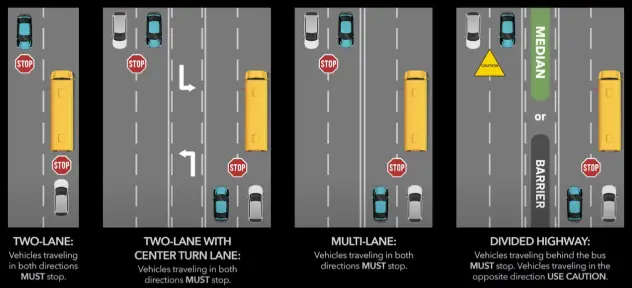School is Open. Do you know when to stop for a school bus?

With our schools back in session, it is a good time to refresh our understanding as to when motorists must stop for a school bus on a divided highway. We have found that even experienced motorists still have some uncertainty when determining whether they are required to stop for school bus on the other side of a multi-lane roadway. Does it matter if the lanes on the roadway are divided by a turning lane, a jersey barrier, a grassy divide or a median strip? Do you know what the law in Pennsylvania requires?
It’s been reported that last October there were more than 250 stop-arm violations in Pennsylvania. In 2020, the Allentown School District captured over 200 vehicles illegally passing two school busses over a 47 day test period.
Because of studies such as this, many school districts are now implementing a camera system which photographs the passing vehicle and issues a citation through the local police department, as part of a cooperative enterprise to keep students safe.
So what are the rules regarding stopping for a school bus?
The general rule is that all motorist must stop at least 10 feet away from a school bus that has its red lights flashing and “stop arm” extended, whether if you behind the bus, meeting the bus from the opposite direction, or approaching an intersection where a bus is stopped. You must remained stopped until the red lights have stopped flashing. If children have exited the bus, you must not move your vehicle until all the children have reached a place of safety off of the roadway.
If you observe the amber lights of the school bus flashing, this is an indication that within 150 to 300 feet the school bus will be activating its red flashing lights and stopping. Drivers can proceed past a school bus if only the amber lights are flashing, but drivers must be prepared to stop when the red lights are flashing and “stop arm” has been extended.
While these rules seem straight forward, the difficulty comes in interpreting the “exception” to the mandatory stopping requirement. 75 Pa.C.S.A. § 3345(g) states that “a driver of a vehicle upon a highway or trafficway with separate roadways need not stop upon meeting or passing a school bus with actuated red signal lights which is on a different roadway.” What does “separate roadway” or “different roadway” mean? The Pennsylvania Code defines “separate roadway” as one roadway of a highway divided into two or more roadways, so as to provide a physical barrier or a clearly indicated dividing section. Pavement markings or signs dividing the roadway cannot be construed as creating a separate roadway. See 67 Pa. Code § 104.2.

So, under this exception, drivers who are approaching a school bus coming in the opposite direction, on the other side of a physically divided highway (median barriers or grassy divide). However, if the opposing lanes of the highway are merely divided by painted lines (even a turning lane) or a raised grooved ridge, then you must stop. This exception only applies if the school bus is on a “different roadway” than what you are traveling on, meaning that if a school bus stops in front of you, even on a barrier divided highway, you still must stop.
Additionally, what is unclear under the law is whether a driver must stop when the road is divided by a raised median section. There is support in at least one case, that a cement median is a sufficient physical barrier to create a “different roadway,” however the court also focused on whether the “barrier” was able to afford children “protection” from passing motorists. Some medians may and some medians may not. When in doubt, you should stop. The safety of our children must be a priority. The penalty for violating this section of the motor vehicle code is severe (60 driver’s license suspension, five points on your driving record and a $250.00 fine).
At Drake, Hileman & Davis, our personal injury attorneys have been concerned for the safety of those in our community for more than 30 years. We have been helping the injured find answers, whenever tragedy strikes. We have a proven track record of results and satisfied clients. We’re ready to answer your questions and provide you with the legal help you need. Contact us on-line or call us at 1-888-777-7098 to schedule your free consultation in the convenience of your home or at one of our five offices located throughout the region.

